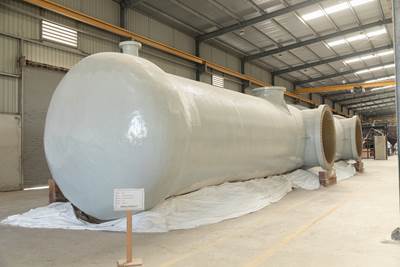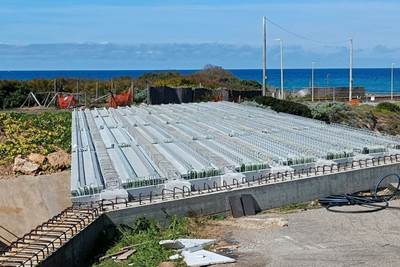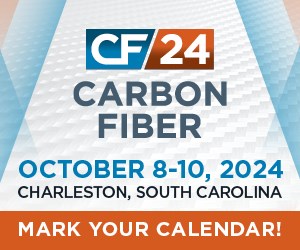FRP Rebar
Industrial equipment manufacturer expands global footprint, reaches into new markets
India-based CW Top Shops honoree EPP Composites reflects on a recently successful vertical filament winding application and new pultruded FRP rebar capabilities, as well as future opportunities.
Hannah Mason
Technical Editor, CompositesWorld
CAMX 2022 exhibit preview: Olin Epoxy
Olin Epoxy offers a portfolio of epoxy systems for challenging applications. Litestone, Voraforce and Airstone aim to resolve problems and support customers’ business growth.
Read MoreUniversity of Miami faculty explore ways to improve resilience of coastal structures
Engineering and ocean sciences faculty members receive federal research funding to delve into how they can strengthen coastal buildings and seawalls in the face of climate change through new materials and better-designed structures.
Read MoreMaterials & Processes: Fibers for composites
The structural properties of composite materials are derived primarily from the fiber reinforcement. Fiber types, their manufacture, their uses and the end-market applications in which they find most use are described.
Read MoreComposite rebar for future infrastructure
GFRP eliminates risk of corrosion and increases durability fourfold for reinforced concrete that meets future demands as traffic, urbanization and extreme weather increase.
Read MoreNeuvokas fiberglass rebar earns Department of Transportation product approval
Texas, Maryland and Virginia have all approved the GatorBar fiberglass rebar product to ensure it meets the highest industry standards.
Read MoreOwens Corning and Pultron Composites form joint venture to produce fiberglass rebar
Composites companies pivot to increase market access to Pinkbar + Fiberglas Rebar and Mateenbar Fiberglas Rebar, expound on the growing rebar industry.
Read MoreSireg Geotech fiberglass rebar supports Italian bridge reconstruction
The ETA-certified composite rebar was applied to the bridge’s precast elements for a lightweight, longer-lasting bridge that is also more resistant to corrosive elements.
Grace Nehls
Senior Managing Editor, CompositesWorld
Basanite basalt rebar chosen to reinforce underground concrete structures
Indian Creek Village, an island municipality located in Florida, selected BasaFlex and BasaMesh fiber reinforcement products as alternatives to steel rebar.
Read MorePultron Composites introduces the Pultrusion Guide
The free, downloadable 15-page guide is geared toward engineers and industry leaders, providing an overview on developing products with pultrusion and GFRP.
Read MoreMateenbar GFRP rebar supports concrete sculpture
The Giant, a six-ton sculpture based in United Arab Emirates, comprises FRP rebar to eliminate the risk of corrosion, extend life cycle and maintenance.
Read MorePultron Composites implements flexible composite rebar for skate park construction
The $2.6 million redevelopment for a skate park in Gisborne, New Zealand, reinforced its concrete with GFRP rebar, which easily bent to accomodate complex curves and improved construction times.
Read MoreSaudi Aramco inaugurates first GFRP rebar production facility
A joint venture between Pultron and IKK now has a dedicated facility, IKK Mateenbar, to manufacture and supply corrosion-free fiberglass rebar for infrastructure projects in Saudia Arabia, the Middle East and North Africa.
Read MoreAramco, ACI launch new center to develop, promote nonmetallic material use for construction
Center of Excellence for Nonmetallic Building Materials to develop, disseminate and adopt consensus-based standards for concrete design, construction and materials.
Read MoreNew standard specification supports non-metallic FRP rebar
ASTM International standard D8505 enables further integration of FRP rebar into infrastructure applications.
Grace Nehls
Senior Managing Editor, CompositesWorld
Advanced Infrastructure Technologies launches third division for FRP composites
New operating division AIT Manufacturing currently offers GBar, GBolt, GMat, GCage and GWall composite products for the infrastructure industry.
Read MoreNational Composites Week: Why are composites essential?
On the last day of the 2020 National Composites Week, composites professionals tell us why they think composites are essential. A million thanks to everyone who participated.
Read MoreNational Composites Week: Top 20 stories in the last decade
As we celebrate National Composites Week, we’ve collected our top content over the last ten years.
Read MoreThe growing role of composites in infrastructure
From bridges to rebar and pilings, composites provide installation and life cycle cost savings over steel and concrete.
Read MoreNational Composites Week: Sustainability
As we celebrate National Composites Week, here are just a few of the many ways the composites industry is working toward a sustainable world.
Read MoreUSQ holds composite rebar workshop
Internationally-renowned expert provides Australian civil and composite engineers with workshop on the use of fiber-reinforced polymer (FRP) composite materials in infrastructure.
Read MoreACI publishes code requirements for GFRP rebar
New comprehensive building code requirement covers the use of nonmetallic, GFRP reinforcing bars in structural concrete applications that are covered by ACI 318-19.
Grace Nehls
Senior Managing Editor, CompositesWorld
Passion, persistence and patience – winning the long game
The American Composite Manufacturers Association (ACMA) and others have been pushing for the widespread use of fiber-reinforced polymer (FRP) rebar in infrastructure construction for decades. Now, the industry is starting to see some major wins.
Read MoreSpecial events round out CAMX experience
CAMX offers several special events for show-goers, which may fit your schedule.
Read MoreCAMX 2018 preview: Olin
Epoxy manufacturer Olin Corp. (Clayton, MO, US) is unveiling several new technologies for composite applications, which will be shown in finished products on display in Olin’s booth
Read MoreCan we achieve global standards for composites?
It is the relative lack of such standards that presents one of the highest hurdles to composites adoption, and also is incredibly difficult to address.
Read MorePultruded composites market growing, says EPTA
The European Pultrusion Technology Association (EPTA, Frankfurt, Germany) has published an in-depth report on its highly successful 2018 conference, held in Vienna on March 1-2, 2018. The 12-page document, World Pultrusion Conference 2018: Attractive Long-Term Prospects for Pultruded Composites, is available to download from the EPTA website.
Read MoreFive highlights from JEC World 2018
It’s not Spring without a trip to Paris, France for the JEC World 2018 composites conference. It’s become a very big show, and thus, offers some big announcements and some developing trends.
Read More













